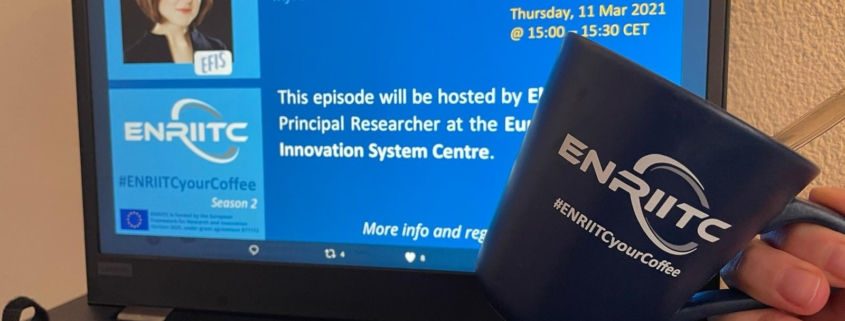#ENRIITCyourCoffee Season 2: Episode 7 – “Monitor and Impact assessment of RIs”
#ENRIITCyourCoffee Season 2 has been a staple of our Thursdays and this session was especially impactful, like the title already suggested. We had the pleasure of having a virtual coffee with Elina Griniece from the European Future Innovation System Centre.
After our traditional coffee mug group photo, the session opened with a presentation by Elina on performance of research infrastructures (RIs) and their socioeconomic impact measuring, in the example of the Research Infrastructure imPact Assessment paTHwayS (RI PATHS) project. “I think everybody involved in this topic acknowledges it’s quite complex because socioeconomic impact is essentially about understanding and tracing interactions,” says Elina.
In short, the aim of RI PATHS was to develop a comprehensive framework to understand and scope socioeconomic impact of all types of RIs. The mission of the project was to give policymakers, funders and RI managers tangible tools to assess impact on the economy and contribution to society.
One of the key terms is impact pathway, which is the understanding of causal chains: how resources invested and activities carried out in RIs led to direct results or ‘output’. The challenge of impact pathways is that when those long–term outcomes diffuse in society, through all the activities and interactions, it is already out of the control and influence of RI management.
Impact pathways are not linear but rather intertwined networks of causes and effects. Elina described the pathways as a tree, where resources and activities are the roots. The trunk is output that directly stems from the resources i.e. roots. Then it branches out to various longer term outcomes and impact is comparable to leaves and blossoms.
All in all, the key contribution from the RI PATHS project was that, through nine interactive workshops with a wide range of RIs, a total of 13 generic impact pathways (or logical chains) were identified and gathered in an online toolkit. “There’s still a long way to go in order to better understand details of impact. And while that aim was achieved, the toolbox is more of a guide into the topic,” Elina says.
Next Elina wanted to ignite the impact assessment process in the audience by outlining the first three steps as an exercise:
- Prerequisite: Internal understanding and management support for impact assessment activities. If this analysis is successful, it can also be a great communication tool because the value of RI can be phrased better, even beyond science.
- Each RI needs to develop an impact assessment framework tailored to their uniqueness. What are the exact impact pathways in a specific RI. Elina adds that this knowledge comes through cooperation within an RI.
- Setting up appropriate monitoring and data collections systems. Elina added that many RIs are already in the phase, where they know what their main socioeconomic impacts are, and actually know a lot about their impact pathways. Next step from there is setting up appropriate monitoring and data collection systems to gather data that’s relevant for this exercise.
The discussion was promptly initiated by Allen Weeks with a great addition to the presentation: While he noticed that over the last 2 years there has been a great leap on the topic of impact pathways, the main question remains – how do we continue with this? Allen believes it is not a one-off enterprise, but is evolving into a discipline. In his mind it would be a regular part of a discussion in meeting rooms, it doesn’t matter if it is CERN or any other RI.
The next addition was added by one of our regular coffee ENRIITCers, Michele Baron, who indicated that at the core of possibly every RI is Return Of Investment (or ROI). He then asked, what is the difference between impact and cost-benefit assessment? Elina responded with understanding the need to quantify, but cost-benefit is only one side of it and understanding the broader impact is also a way of quantifying.
Michele swiftly pointed out that a common definition of impacts is certainly needed and Elina added that this is an ongoing discussion, to which the RI PATHS project was a battleground of sorts. It was noted that the average politician pays more attention to the cost–benefits than on the impact in society. Elina admits that this has always been the case, but during the project they noticed there is a need and a start in the shift in the discourse. “It’s not always the quantification that’s necessary. You also need the quantification on meaning attached to it.”
Sophie Pireaux took the discussion further and shared links to the brochure on the matters of socioeconomic impact with the group. She agreed with Elina that impact is broader than cost benefits but both are useful. Sophie also noted that as a council representative, the questions have moved further from just numbers to a broader impact, which is a positive shift.
Corinne Martin from ELIXIR worked with Elina on the RI PATHS project and admitted that while she initially had grand ideas, she soon had to scale back to issues closer to home such as research efficiency, making things faster, easier for the users of our services.
“It was about relationship capital because we are an RI of people beyond data. It was about human capital, European people, their skills, providing training and so on. And of course this can lead to socioeconomic impact if you follow a very long pathway of impact.”
Corinne also expressed that as a scientist, she was worried about data, but impact can also be quantified by measuring perceptions, which are equally important.
Allen Weeks ended with a truly insightful thought: the discussion should move beyond from a cost-benefit idea since from an economic perspective it’s not always easy make a strong argument for an RI like it is for a company because RIs don’t operate in the same sphere as a company.
“Like the tree: you can measure and count the number of leaves on the tree, but maybe the impact is if the acorns fall and did other trees grow? Is there a shaded area under the tree where other plants could grow?”
While our session was also visited by a passing troll, it might just show that our virtual coffees are starting to have a bigger impact.
#ENRIITCyourCoffee will return with Episode 8 “Training Opportunities for ILOs” on 18 March at 15:00 CET. That session will be led by Sylwia Wójtowicz, ILO for CERN and F4E. Registration is open here, and you can check out our LinkedIn group here.







Leave a Reply
Want to join the discussion?Feel free to contribute!